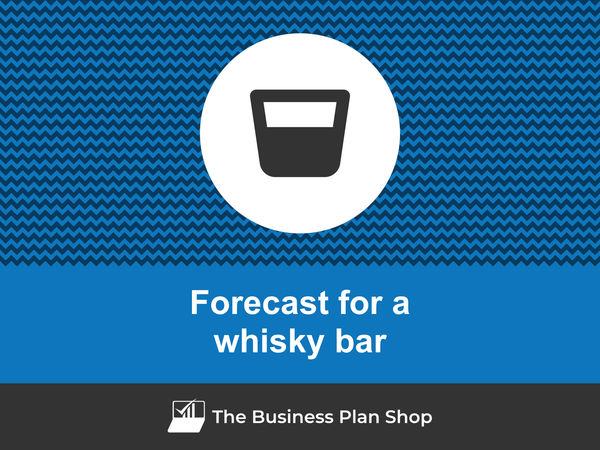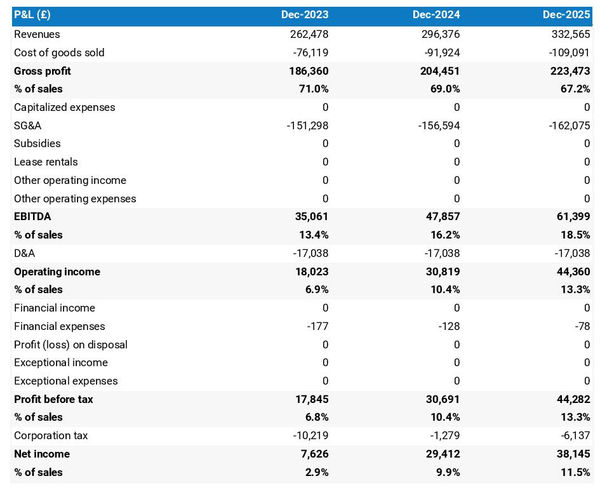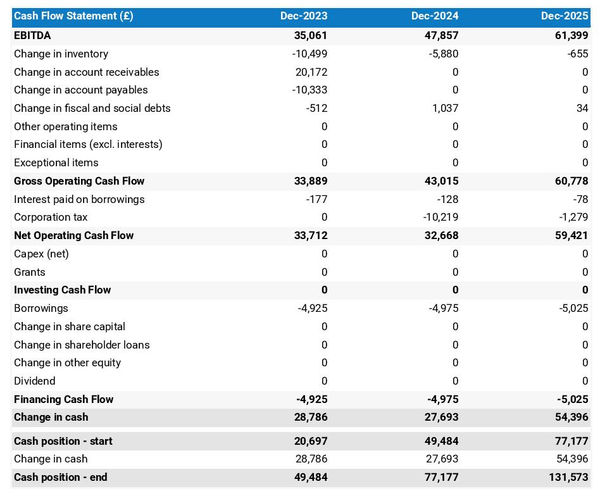How to create a financial forecast for a whisky bar?

If you are serious about keeping visibility on your future cash flows, then you need to build and maintain a financial forecast for your whisky bar.
Putting together a whisky bar financial forecast may sound complex, but don’t worry, with the right tool, it’s easier than it looks, and The Business Plan Shop is here to guide you.
In this practical guide, we'll cover everything you need to know about building financial projections for your whisky bar.
We will start by looking at why they are key, what information is needed, what a forecast looks like once completed, and what solutions you can use to create yours.
Let's dive in!
Why create and maintain a financial forecast for a whisky bar?
Creating and maintaining an up-to-date financial forecast is the only way to steer the development of your whisky bar and ensure that it can be financially viable in the years to come.
A financial plan for a whisky bar enables you to look at your business in detail - from income to operating costs and investments - to evaluate its expected profitability and future cash flows.
This gives you the visibility needed to plan future investments and expansion with confidence.
And, when your trading environment gets tougher, having an up to date whisky bar forecast enables you to detect potential upcoming financing shortfalls in advance, enabling you to make adjustments or secure financing before you run out of cash.
It’s also important to remember that your whisky bar's financial forecast will be essential when looking for financing. You can be 100% certain that banks and investors will ask to see your numbers, so make sure they’re set out accurately and attractively.
Need a solid financial forecast?
The Business Plan Shop does the maths for you. Simply enter your revenues, costs and investments. Click save and our online tool builds a three-way forecast for you instantly.

What information is used as input to build a whisky bar financial forecast?
A whisky bar's financial forecast is only as good as the inputs used to build it.
If you are creating (or updating) the forecast of an existing whisky bar, then you mostly need your accounting information, key historical operating non-financial data, and your team’s input on what to expect for the coming years.
If you are building financial projections for a whisky bar startup, you will need to have done your research and have a clear picture of your competitive environment and go-to-market strategy so that you can forecast sales accurately.
For a new venture, you will also need a precise list of the resources needed to keep the whisky bar running on a day-to-day basis and a list of the equipment and expenditures required to start the business (more on that later).
Let's now take a closer look at the elements that make up your whisky bar's financial forecast.
The sales forecast for a whisky bar
From experience, it is usually best to start creating your whisky bar financial forecast by your sales forecast.
To create an accurate sales forecast for your whisky bar, you will have to rely on the data collected in your market research, or if you're running an existing whisky bar, the historical data of the business, to estimate two key variables:
- The average price
- The number of monthly transactions
To get there, you will need to consider the following factors:
- Consumer Trends: Keep an eye on consumer trends in the whisky industry, as they can greatly affect the average price of your whiskies. For example, a sudden increase in demand for a particular type of whisky can drive up the price, while a shift in consumer preferences may result in a decrease in sales.
- Availability of Rare Whiskies: The availability of rare and limited edition whiskies can also impact your average price. When these highly sought-after whiskies are in short supply, customers may be willing to pay a premium price to try them.
- Seasonal Variations: The time of year can also have an effect on your monthly transactions. For instance, during the colder months, customers may be more inclined to purchase whisky as a warming drink, resulting in higher sales. On the other hand, during summer months, sales may decrease as people opt for lighter, refreshing drinks.
- Economic Conditions: Keep an eye on the overall economic conditions in your area, as they can impact consumer spending habits. During times of economic uncertainty, people may be less likely to spend money on luxury items like whisky, resulting in a decrease in sales.
- Demographics: The demographics of your target market can also affect your average price and number of monthly transactions. For example, if your bar is located in an area with a high-income population, you may be able to charge higher prices for your whiskies compared to a bar in a lower-income area.
Once you have an idea of what your future sales will look like, it will be time to work on your overhead budget. Let’s see what this entails.
Need inspiration for your business plan?
The Business Plan Shop has dozens of business plan templates that you can use to get a clear idea of what a complete business plan looks like.

The operating expenses for a whisky bar
The next step is to estimate the costs you’ll have to incur to operate your whisky bar.
These will vary based on where your business is located, and its overall size (level of sales, personnel, etc.).
But your whisky bar's operating expenses should normally include the following items:
- Staff costs: This includes salaries, wages, benefits, and any other compensation for your employees. For a whisky bar, this may also include tips and commissions for bartenders and servers.
- Accountancy fees: You may need to hire an accountant to help with bookkeeping, payroll, tax preparation, and other financial tasks.
- Insurance costs: As a business owner, it's important to protect your assets and employees with various insurance policies, such as liability insurance, property insurance, and worker's compensation insurance.
- Software licenses: To keep your business running smoothly, you may need to invest in software licenses for point-of-sale systems, inventory management, accounting, and other operations.
- Banking fees: Your business bank account may charge fees for various transactions, such as wire transfers, check processing, and ATM withdrawals.
- Rent: The cost of leasing or renting a space for your whisky bar.
- Utilities: This includes electricity, water, gas, and any other necessary utilities for running your bar.
- Inventory: Whisky is the main product of your bar, so you'll need to budget for purchasing, storing, and managing inventory.
- Marketing and advertising: To attract customers to your bar, you may need to spend money on advertising, promotions, and events.
- Liquor license and permits: Depending on your location, you may need to obtain a liquor license and other permits to legally operate a whisky bar.
- Cleaning and maintenance: To maintain a clean and welcoming atmosphere for your customers, you'll need to budget for cleaning supplies, equipment, and possibly professional cleaning services.
- Credit card processing fees: If you accept credit and debit cards as payment, you'll need to pay fees to the credit card processing company.
- Entertainment: To enhance the experience for your customers, you may want to budget for live music, trivia nights, or other forms of entertainment.
- Training and development: To ensure your staff is knowledgeable and skilled in whisky and mixology, you may need to invest in training and development programs.
- Legal fees: As a business owner, you may encounter legal issues or need to consult with a lawyer for various matters, so it's important to budget for potential legal fees.
This list is not exhaustive by any means, and will need to be tailored to your whisky bar's specific circumstances.
What investments are needed to start or grow a whisky bar?
Creating and expanding a whisky bar also requires investments which you need to factor into your financial forecast.
Capital expenditures and initial working capital items for a whisky bar could include elements such as:
- Whisky inventory: This includes the cost of purchasing various types of whisky to stock your bar. This can also include the cost of aging whisky in barrels.
- Bar equipment: This includes items such as a commercial-grade refrigerator, ice machine, glassware, and other essential equipment needed to operate a whisky bar.
- Furniture and decor: This includes tables, chairs, bar stools, and other furniture to create a comfortable and inviting atmosphere for your customers. It can also include decorative elements such as artwork and lighting fixtures.
- POS system: A point-of-sale system is necessary for any bar or restaurant to track sales and inventory. This includes hardware such as cash registers, tablets, or computers, as well as software and setup fees.
- Security system: To protect your bar and its assets, a security system is essential. This can include cameras, alarms, and other security equipment.
Again, this list is not exhaustive and will need to be adjusted according to the circumstances of your whisky bar.
Need a convincing business plan?
The Business Plan Shop makes it easy to create a financial forecast to assess the potential profitability of your projects, and write a business plan that’ll wow investors.

The financing plan of your whisky bar
The next step in the creation of your financial forecast for your whisky bar is to think about how you might finance your business.
You will have to assess how much capital will come from shareholders (equity) and how much can be secured through banks.
Bank loans will have to be modelled so that you can separate the interest expenses from the repayments of principal, and include all this data in your forecast.
Issuing share capital and obtaining a bank loan are two of the most common ways that entrepreneurs finance their businesses.
What tables compose the financial plan for a whisky bar?
Now let's have a look at the main output tables of your whisky bar's financial forecast.
The projected profit & loss statement
The projected profit & loss shows how profitable your whisky bar is likely to be in the years to come.

For your whisky bar to be financially viable, your projected P&L should ideally show:
- Sales growing above inflation (the higher the better)
- Profit margins which are stable or expanding (the higher the better)
- A net profit at the end of each financial year (the higher the better)
This is for established whisky bars, there is some leniency for startups which will have numbers that will look a bit different than existing businesses.
The projected balance sheet
Your whisky bar's projected balance sheet provides a snapshot of your business’s financial position at year-end.
It is composed of three types of elements: assets, liabilities and equity:
- Assets: represent what the business possesses including cash, equipment, and accounts receivable (money owed by clients).
- Liabilities: represent funds advanced to the business by lenders and other creditors. They include accounts payable (money owed to suppliers), taxes payable and loans from banks and financial institutions.
- Equity: is the combination of what has been invested by the business owners and the cumulative profits and losses generated by the business to date (which are called retained earnings). Equity is a proxy for the value of the owner's stake in the business.

The cash flow projection
The cash flow forecast of your whisky bar will show how much cash the business is expected to generate or consume over the next three to five years.

There are multiple ways of presenting a cash flow forecast but from experience, it is better to organise it by nature in order to clearly show these elements:
- Operating cash flow: how much cash is generated by the whisky bar's operations
- Investing cash flow: what is the business investing to expand or maintain its equipment
- Financing cash flow: is the business raising additional funds or repaying financiers (debt repayment, dividends)
Your cash flow forecast is the most important element of your overall financial projection and that’s where you should focus your attention to ensure that your whisky bar is adequately funded.
Note: if you are preparing a financial forecast in order to try to secure funding, you will need to include both a yearly and monthly cash flow forecast in your whisky bar's financial plan.
Need a solid financial forecast?
The Business Plan Shop does the maths for you. Simply enter your revenues, costs and investments. Click save and our online tool builds a three-way forecast for you instantly.

Which tool should you use to create your whisky bar's financial forecast?
Using the right tool or solution will make the creation of your whisky bar's financial forecast much easier than it sounds. Let’s explore the main options.
Using online financial forecasting software to build your whisky bar's projections
The modern and easiest way is to use professional online financial forecasting software such as the one we offer at The Business Plan Shop.
There are several advantages to using specialised software:
- You can easily create your financial forecast by letting the software take care of the financial calculations for you without errors
- You have access to complete financial forecast templates
- You get a complete financial forecast ready to be sent to your bank or investors
- You can easily track your actual financial performance against your financial forecast, and recalibrate your forecast as the year goes by
- You can create scenarios to stress test your forecast's main assumptions
- You can easily update your forecast as time goes by to maintain visibility on future cash flows
- You have a friendly support team on standby to assist you when you are stuck
- It’s cost-efficient and much cheaper than using an accountant or consultant (see below)
If you are interested in this type of solution, you can try our forecasting software for free by signing up here.
Calling in a financial consultant or chartered accountant
Enlisting the help of a consultant or accountant is also a good way to obtain a professional whisky bar financial forecast.
The downside of this solution is its cost. From experience, obtaining a simple financial forecast over three years (including a balance sheet, income statement, and cash flow statement) is likely to cost a minimum of £700 or $1,000.
The indicative cost above, is for a small business, and a forecast is done as a one-shot exercise. Using a consultant or accountant to track your actuals vs. forecast and to keep your financial projections up to date on a monthly or quarterly basis will cost a lot more.
If you opt for this solution, make sure your accountant has in-depth knowledge of your industry, so that they may challenge your figures and offer insights (as opposed to just taking your assumptions at face value to create the forecast).
Why not use a spreadsheet such as Excel or Google Sheets to build your whisky bar's financial forecast?
You and your financial partners need numbers you can trust. Unless you have studied finance or accounting, creating a trustworthy and error-free whisky bar financial forecast on a spreadsheet is likely to prove challenging.
Financial modelling is very technical by nature and requires a solid grasp of accounting principles to be done without errors. This means that using spreadsheet software like Excel or Google Sheets to create accurate financial forecasts is out of reach for most business owners.
Creating forecasts in Excel is also inefficient nowadays:
- Software has advanced to the point where forecasting can be done much faster and more accurately than manually on a spreadsheet.
- With artificial intelligence, the software is capable of detecting mistakes and helping decision-making.
Spreadsheets are versatile tools but they are not tailor-made for reporting. Importing your whisky bar's accounting data in Excel to track actual vs. forecast is incredibly manual and tedious (and so is keeping forecasts up to date). It is much faster to use dedicated financial planning tools like The Business Plan Shop which are built specially for this.
Need a convincing business plan?
The Business Plan Shop makes it easy to create a financial forecast to assess the potential profitability of your projects, and write a business plan that’ll wow investors.

Use our financial projection templates for inspiration
The Business Plan Shop has dozens of financial forecast templates available.
Our examples contain a complete business plan with a financial forecast and a written presentation of the company, the team, the strategy, and the medium-term objectives.
Whether you are just starting out or already have your own whisky bar, looking at our financial forecast template is a good way to:
- Understand what a complete business plan should look like
- Understand how you should model financial items for your whisky bar

Takeaways
- A financial projection shows expected growth, profitability, and cash generation for your business over the next three to five years.
- Tracking actuals vs. forecast and keeping your financial forecast up-to-date is the only way to maintain visibility on future cash flows.
- Using financial forecasting software makes it easy to create and maintain up-to-date projections for your whisky bar.
You have reached the end of our guide. We hope you now have a better understanding of how to create a financial forecast for a whisky bar. Don't hesitate to contact our team if you have any questions or want to share your experience building forecasts!
Need inspiration for your business plan?
The Business Plan Shop has dozens of business plan templates that you can use to get a clear idea of what a complete business plan looks like.

Also on The Business Plan Shop
Know someone who runs or wants to start a whisky bar? Share our financial projection guide with them!




